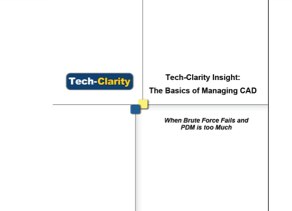 Tech-Clarity Insight The Basics of Managing CAD – When Brute Force Fails and PDM is too Much explains the need to manage CAD files and the current options available to manufacturers. The report analyzes the positives and negatives of manually managed approaches, implementing PDM/PLM, and utilizing cloud-based file management services. The research then reviews the basic necessities of CAD management – controlling, accessing, and sharing files – in order to uncover what a “just the basics” solution requires to determine if there are lower overhead methods (such as cloud services) that can be applied. The report shares the experience of two companies, Hippo Engineering and HemoSonics, that have adopted a cloud based approach to managing CAD files.
Tech-Clarity Insight The Basics of Managing CAD – When Brute Force Fails and PDM is too Much explains the need to manage CAD files and the current options available to manufacturers. The report analyzes the positives and negatives of manually managed approaches, implementing PDM/PLM, and utilizing cloud-based file management services. The research then reviews the basic necessities of CAD management – controlling, accessing, and sharing files – in order to uncover what a “just the basics” solution requires to determine if there are lower overhead methods (such as cloud services) that can be applied. The report shares the experience of two companies, Hippo Engineering and HemoSonics, that have adopted a cloud based approach to managing CAD files.
Please enjoy the summary below, or click the report to download a PDF overview (free of charge, no registration required).
For the full report, please visit our sponsor, GrabCAD (free of charge, registration required).
Table of Contents
- Executive Overview
- Understand the Need to Manage CAD Data
- Explore CAD Data Management Options
- Explore the Options – Manual Approaches
- Explore the Options – PDM or PLM
- Explore the Options – Cloud File-Sharing
- Identify Basic Requirements for CAD Management
- Gain Control
- Provide Access
- Share Your CAD
- Get the Basics without the Overhead?
- Conclusion
- Recommendations
- About the Author
Executive Overview
Engineering, by its nature, is a logical and structured discipline. It’s no surprise, then, to see the level of organization that engineers apply to managing their CAD files. Unfortunately, many engineers manage files using meaningful file names on their hard drive. As the number of engineers on a project increases, managing files in a directory structure gets increasingly risky. Simply transforming the directory structure to a shared drive is not enough to manage multiple design iterations and have confidence that you can always find the current version. Or make sure that another designer doesn’t overwrite your hard work. Or really ever expect to find what you are looking for.
Some recognize the shortcomings and risks of a manual CAD management approach, while others are one mistake away from learning the hard way. “An unmanaged approach works OK for one person, but when you ask for something they spend a half a day scrambling to get data together,” cautions Jake Myre, owner of Hippo Engineering. “Then, they end up having a part made for a prototype and find out it’s three versions old. That’s not good.”
Beyond managing their own work, few engineers work in a vacuum. They must coordinate with other designers, contractors, suppliers, prototype shops, contract manufacturers, and others that need CAD data to do their jobs. PDM and PLM are formal, traditional systems designed to help manufacturers control, access, and share their CAD data. But as Tech-Clarity’s Managing Design Data with SharePoint concludes, “Unfortunately, data management solutions have been out of reach … due to cost and lack of IT resources.”
But engineers have to do something. Living in an unmanaged, manual environment is highly inefficient and prone to errors. For companies that have outgrown chaos and are tired of crossing their fingers and hoping they don’t order or produce the wrong part, it’s time for a practical solution. Fortunately, there are more options available today than ever before, including new cloud-based tools. It’s time for a rational discussion to explore the basic requirements for CAD data management and discuss whether they can be achieved without the cost and complexity that make traditional solutions impractical for many smaller manufacturers. This report concludes that a simplified, cloud-based CAD data management approach can provide important benefits with significantly reduced investment of time, money, and IT expertise.

